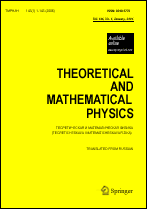|
This article is cited in 3 scientific papers (total in 3 papers)
A differential $\mathscr U$-module algebra for $\mathscr{U}=\overline{\mathscr U}_{\mathfrak{q}}s\ell(2)$ at an even root of unity
A. M. Semikhatov
P. N. Lebedev Physical Institute, Russian Academy of Sciences
Abstract:
We show that the full matrix algebra $\operatorname{Mat}_p(\mathbb{C})$ is a $\mathscr{U}$-module algebra for $\mathscr{U}=\overline{\mathscr{U}}_{\mathfrak{q}}s\ell(2)$, a quantum $s\ell(2)t$ group at the $2p$th root of unity. The algebra $\operatorname{Mat}_p(\mathbb{C})$ decomposes into a direct sum of projective $\mathscr{U}$-modules $\mathscr{P}^+_n$ with all odd $n$, $1\le n\le p$. In terms of generators and relations, this $\mathscr{U}$-module algebra is described as the algebra of $q$-differential operators “in one variable”; with the relations $\partial z=\mathfrak{q}-\mathfrak{q}^{-1}+\mathfrak{q}^{-2}z\partial$ and $z^p=\partial^p=0$. These relations define a “parafermionic”; statistics that generalizes the fermionic commutation relations. By the Kazhdan–Lusztig duality, it is to be realized in a manifestly quantum-group-symmetric description of $(p,1)$ logarithmic conformal field models. We extend the Kazhdan–Lusztig duality between $\mathscr{U}$ and the $(p,1)$ logarithmic models by constructing a quantum de Rham complex of the new $\mathscr{U}$-module algebra and discussing its field theory counterpart.
Keywords:
quantum group, parafermionic statistics, $\mathscr U$-module algebra, Kazhdan–Lusztig duality, logarithmic conformal field theory.
Received: 13.09.2008
Citation:
A. M. Semikhatov, “A differential $\mathscr U$-module algebra for $\mathscr{U}=\overline{\mathscr U}_{\mathfrak{q}}s\ell(2)$ at an even root of unity”, TMF, 159:1 (2009), 5–33; Theoret. and Math. Phys., 159:1 (2009), 424–447
Linking options:
https://www.mathnet.ru/eng/tmf6330https://doi.org/10.4213/tmf6330 https://www.mathnet.ru/eng/tmf/v159/i1/p5
|


|




 Contact us:
Contact us: Terms of Use
Terms of Use
 Registration to the website
Registration to the website Logotypes
Logotypes







 Citation in format
Citation in format 
